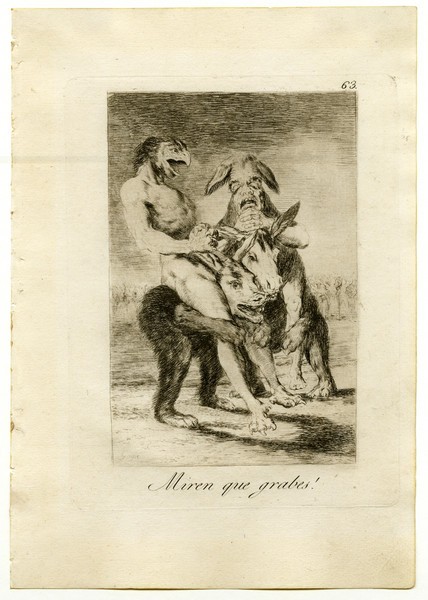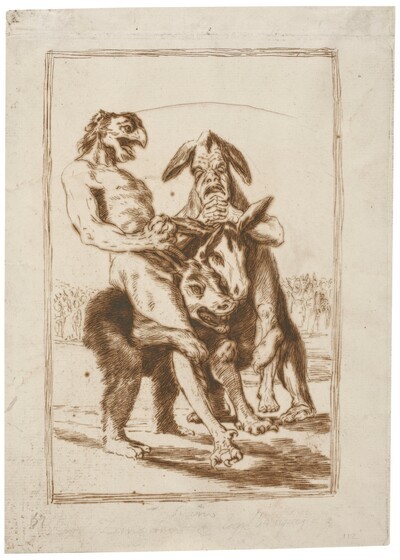- Cronología
- Ca. 1797 - 1799
- Dimensiones
- 215 x 163 mm
- Técnica y soporte
- Aguafuerte, aguatinta y punta seca
- Reconocimiento de la autoría de Goya
- Undisputed work
- Ficha: realización/revisión
- 29 Dec 2010 / 29 May 2024
- Inventario
- 225
Miren que grabes! (at the bottom)
63. (in the upper right-hand corner)
Goya (in the bottom left-hand corner).
See Francisco de Goya y Lucientes, Painter.
A proof before the letter is preserved in the Museum of Fine Arts, Boston. In the first printings the title ends in a full stop instead of an exclamation mark.
The preparatory drawing for this engraving is in the Prado Museum.
Two monstrous beings with the head of an ass and the body of an ape, standing on their hindquarters, carry two other equally deformed figures on their shoulders. The one in the foreground has the head of an eagle and the body of a man, with claw-like hands and fingers interlaced in prayer. Somewhat further back is another figure with a human body and face and the ears of a donkey. The scene takes place on a plain, in the background of which a crowd of people can be seen watching this peculiar image.
In this print Goya used aquatint in a single tone, while he made extensive use of etching to define the hairy bodies of the animals carrying other monstrous beings on their shoulders, as well as the sky.
The explanations provided by the manuscripts of this engraving have some nuances that make them different. The Ayala manuscript states the following: "Two beastly figures are exercising on horseback. The one is famous for his devotion and the other for his thievery". In the Museo Nacional del Prado manuscript, the explanation is more oriented towards witchcraft: "The print indicates that these two witches of convenience and authors have gone out for a bit of exercise on horseback". Finally, the manuscript in the Biblioteca Nacional comments on this engraving as follows: "One sees nothing in the world but monstrosities: two monstrous beasts carry two people on their shoulders: the one appears to be brave, but a thief; the other a fanatic, but a savage. Such are the kings and chief magistrates of the people; and with all this they call them from afar; they acclaim them and entrust the government to them".
In short, one might think that this engraving virulently denounces the abuses of authority and those who despotically exercise power. It was precisely they who fostered ignorance among the people, making them incapable of freeing themselves from this yoke.
The plate is preserved in the National Chalcography (no. 234).
-
Goya. Das Zeitalter der Revolucionen. Kunst um 1800 (1980 – 1981)Hamburger KunsthalleHamburg1980cat. 57
-
Goya. La década de Los CaprichosMadrid1992organized by Real Academia de Bellas Artes de San Fernando sponsored by Fundación Central Hispano, Madrid, consultant editor Nigel Glendinnig. From October 26th 1992 to January 10th 1993cat. 117
-
Francisco de GoyaMuseo d'Arte ModernaLugano1996exhibition celebrated from September 22nd to November 17th.cat. 63, p.90
-
Francisco Goya. Sein leben im spiegel der graphik. Fuendetodos 1746-1828 Bordeaux. 1746-1996Galerie KornfeldBern1996from November 21st 1996 to January 1997cat. 69
-
Goya artista de su tiempo y Goya artista únicoThe National Museum of Western ArtTokyo1999from December 1st to July 3th 1999cat. 121
-
Goya e la tradizione italianaFondazione Magnani RoccaMamiano di Traversetolo (Parma)2006consultant editors Fred Licht and Simona Tosini Pizzetti. From September 9th to December 3th 2006cat. 63, p.161
-
Goya. Opera graficaPinacoteca del Castello di San GiorgioLegnano2006exhibition celebrated from December 16th 2006 to April 1st 2007p.40
-
Goya et la modernitéPinacothèque de ParisParís2013from October 11st 2013 to March 16th 2014cat. 166
-
Goya engravings and lithographs, vol. I y II.OxfordBruno Cassirer1964p.140, cat. 98
-
Vie et ouvre de Francisco de GoyaParísOffice du livre1970p.183, cat. 577
-
Goya, la década de los caprichos: dibujos y aguafuertesMadridReal Academia de Bellas Artes de San Fernando1992pp.198-199, cat. 117
-
Catálogo de las estampas de Goya en la Biblioteca NacionalMadridMinisterio de Educación y Cultura, Biblioteca Nacional1996p.107, cat. 153
-
El libro de los caprichos: dos siglos de interpretaciones (1799-1999). Catálogo de los dibujos, pruebas de estado, láminas de cobre y estampas de la primera ediciónMadridMuseo Nacional del Prado1999pp.322-325
-
ParísPinacoteca de París2013p. 231
-
Goya. In the Norton Simon MuseumPasadenaNorton Simon Museum2016pp. 42-75

